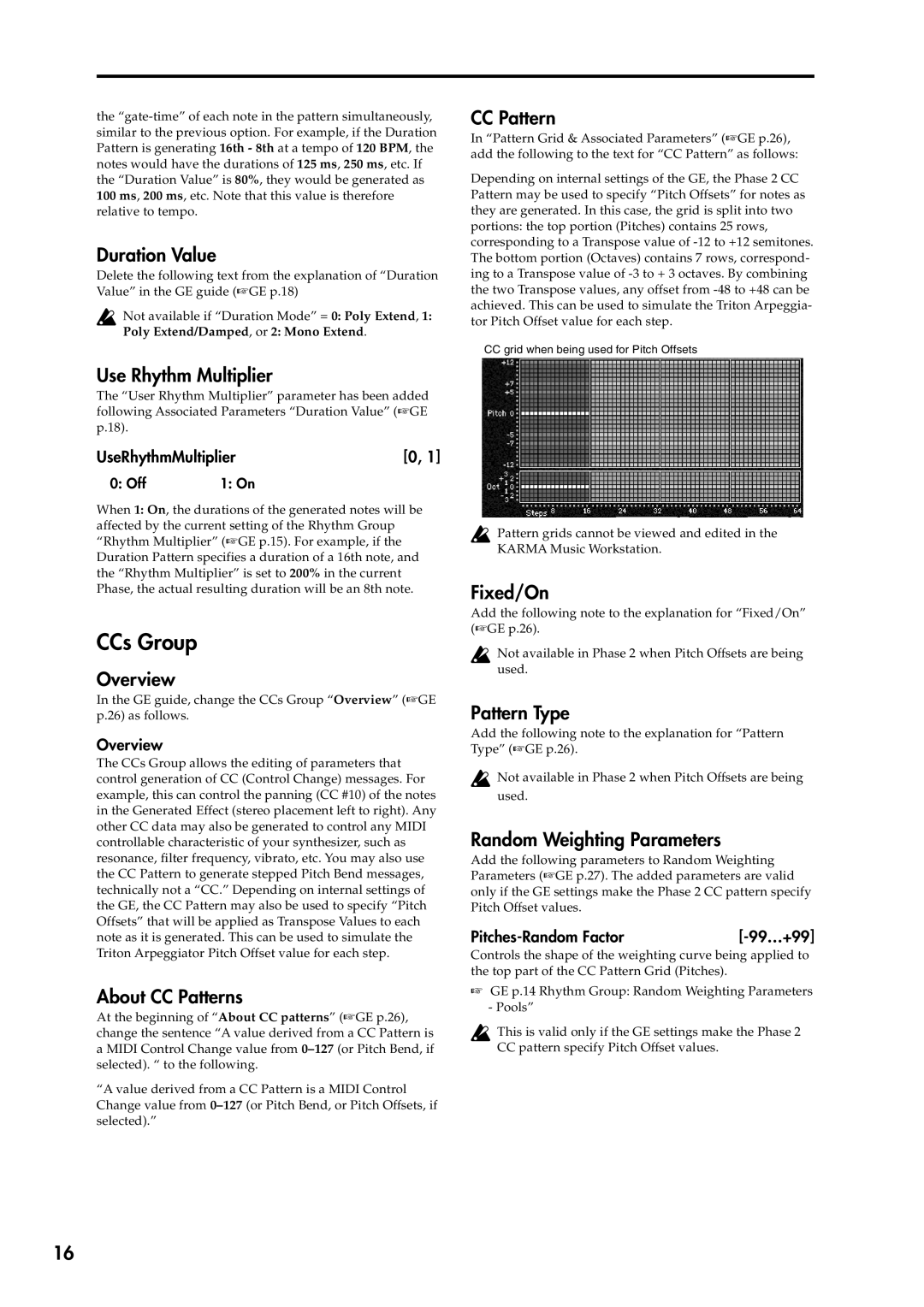
the
Duration Value
Delete the following text from the explanation of “Duration Value” in the GE guide (☞GE p.18)
Not available if “Duration Mode” = 0: Poly Extend, 1:
Poly Extend/Damped, or 2: Mono Extend.
Use Rhythm Multiplier
The “User Rhythm Multiplier” parameter has been added following Associated Parameters “Duration Value” (☞GE p.18).
UseRhythmMultiplier | [0, 1] | |
0: Off | 1: On |
|
When 1: On, the durations of the generated notes will be affected by the current setting of the Rhythm Group “Rhythm Multiplier” (☞GE p.15). For example, if the Duration Pattern specifies a duration of a 16th note, and the “Rhythm Multiplier” is set to 200% in the current Phase, the actual resulting duration will be an 8th note.
CCs Group
Overview
In the GE guide, change the CCs Group “Overview” (☞GE p.26) as follows.
Overview
The CCs Group allows the editing of parameters that control generation of CC (Control Change) messages. For example, this can control the panning (CC #10) of the notes in the Generated Effect (stereo placement left to right). Any other CC data may also be generated to control any MIDI controllable characteristic of your synthesizer, such as resonance, filter frequency, vibrato, etc. You may also use the CC Pattern to generate stepped Pitch Bend messages, technically not a “CC.” Depending on internal settings of the GE, the CC Pattern may also be used to specify “Pitch Offsets” that will be applied as Transpose Values to each note as it is generated. This can be used to simulate the Triton Arpeggiator Pitch Offset value for each step.
About CC Patterns
At the beginning of “About CC patterns” (☞GE p.26), change the sentence “A value derived from a CC Pattern is a MIDI Control Change value from
“A value derived from a CC Pattern is a MIDI Control Change value from
CC Pattern
In “Pattern Grid & Associated Parameters” (☞GE p.26), add the following to the text for “CC Pattern” as follows:
Depending on internal settings of the GE, the Phase 2 CC Pattern may be used to specify “Pitch Offsets” for notes as they are generated. In this case, the grid is split into two portions: the top portion (Pitches) contains 25 rows, corresponding to a Transpose value of
CC grid when being used for Pitch Offsets
Pattern grids cannot be viewed and edited in the KARMA Music Workstation.
Fixed/On
Add the following note to the explanation for “Fixed/On” (☞GE p.26).
Not available in Phase 2 when Pitch Offsets are being used.
Pattern Type
Add the following note to the explanation for “Pattern Type” (☞GE p.26).
Not available in Phase 2 when Pitch Offsets are being used.
Random Weighting Parameters
Add the following parameters to Random Weighting Parameters (☞GE p.27). The added parameters are valid only if the GE settings make the Phase 2 CC pattern specify Pitch Offset values.
|
|
Controls the shape of the weighting curve being applied to the top part of the CC Pattern Grid (Pitches).
☞GE p.14 Rhythm Group: Random Weighting Parameters
-Pools”
This is valid only if the GE settings make the Phase 2 CC pattern specify Pitch Offset values.
16
